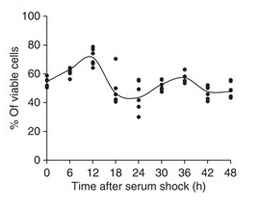Research Abstract
マイクロRNAのmiR-96-5pの量の律動的な変化はグルタチオン濃度を間接的に調節することにより神経保護的な役割を果たす
Rhythmic oscillations of the microRNA miR-96-5p play a neuroprotective role by indirectly regulating glutathione levels
2014年5月7日 Nature Communications 5 : 3823 doi: 10.1038/ncomms4823

グルタチオン(GSH)は、脳内で神経防御に重要な役割を果たしている抗酸化物質である。GSH量の低下は、パーキンソン病やアルツハイマー病のような神経変性疾患と関連づけられている。本論文では、ドーパミン作動性細胞でのGSH量の日内変動が酸化ストレスに対する神経防御活性と相関していることを示す。また、神経細胞でのGSH合成に関わっているシステイン輸送体のEAAC1(excitatory amino acid carrier 1)は、存在量が日内変動するマイクロRNAであるmiR-96-5pによって負の調節を受けていることが分かった。miR-96-5pの働きを阻害剤の脳室内投与によって阻害すると、EAAC1だけでなくGSHの量も増加し、マウス黒質では酸化ストレスに対する神経防御効果が認められた。我々の結果は、miR-96-5p量の日内変動により、神経細胞のGSH量がEAAC1を介して調節されることにより神経防御に役割を果たしている可能性を示している。
木下 千智1, 青山 晃治1, 松村 暢子1, 内海 計1, 渡部 正彦1,2 & 中木 敏夫1
- 帝京大学 医学部 薬理学
- 帝京大学 医療共通教育センター
Glutathione (GSH) is a key antioxidant that plays an important neuroprotective role in the brain. Decreased GSH levels are associated with neurodegenerative diseases such as Parkinson’s disease and Alzheimer’s disease. Here we show that a diurnal fluctuation of GSH levels is correlated with neuroprotective activity against oxidative stress in dopaminergic cells. In addition, we found that the cysteine transporter excitatory amino acid carrier 1 (EAAC1), which is involved in neuronal GSH synthesis, is negatively regulated by the microRNA miR-96-5p, which exhibits a diurnal rhythm. Blocking miR-96-5p by intracerebroventricular administration of an inhibitor increased the level of EAAC1 as well as that of GSH and had a neuroprotective effect against oxidative stress in the mouse substantia nigra. Our results suggest that the diurnal rhythm of miR-96-5p may play a role in neuroprotection by regulating neuronal GSH levels via EAAC1.

